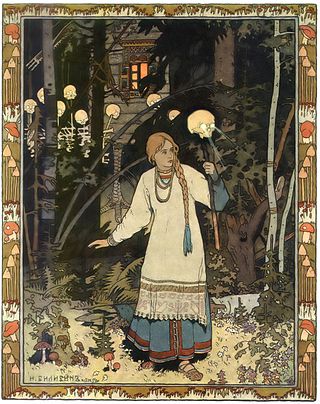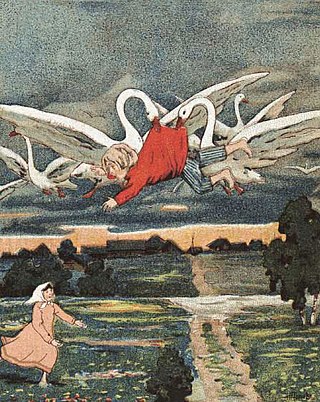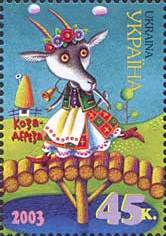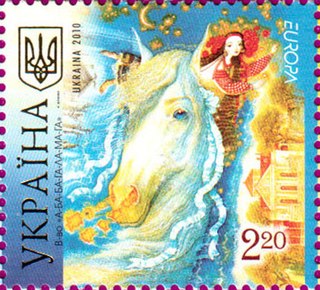
The StoryTeller is a live-action/puppet television series that originally aired in 1987 and which was created and produced by Jim Henson.

In Slavic mythology and folklore, the Firebird is a magical and prophetic glowing or burning bird from a faraway land which is both a blessing and a harbinger of doom to its captor.

The Frog Princess is a fairy tale that has multiple versions with various origins. It is classified as type 402, the animal bride, in the Aarne–Thompson index. Another tale of this type is the Norwegian Doll i' the Grass. Eastern European variants include the Frog Princess or Tsarevna Frog and also Vasilisa the Wise ; Alexander Afanasyev collected variants in his Narodnye russkie skazki, a collection which included folk tales from Ukraine and Belarus alongside Russian tales.

The "swan maiden" story is a name in folkloristics used to refer to three kinds of stories: those where one of the characters is a bird-maiden, in which she can appear either as a bird or as a woman; those in which one of the elements of the narrative is the theft of the feather-robe belonging to a bird-maiden, though it is not the most important theme in the story; and finally the most commonly referred to motif, and also the most archaic in origin: those stories in which the main theme, among several mixed motifs, is that of a man who finds the bird-maiden bathing and steals her feathered robe, which leads to him becoming married to the bird-maiden. Later, the maiden recovers the robe and flies away, returning to the sky, and the man may seek her again. It is one of the most widely distributed motifs in the world, most probably being many millennia old, and the best known supernatural wife figure in narratives.

Vasilisa the Beautiful or Vasilisa the Fair is a Russian fairy tale collected by Alexander Afanasyev in Narodnye russkie skazki.

The Magic Swan Geese is a Russian fairy tale collected by Alexander Afanasyev in Narodnye russkie skazki, numbered 113.

Emelya the Simpleton or At the Pike's Behest is a Russian fairy tale collected by Alexander Afanasyev in Narodnye russkie skazki.

Kolobok is the main character of an East Slavic fairy-tale with the same name, represented as a small yellow spherical bread-like being. The story is often called "Little Round Bun" and sometimes "The Runaway Bun."

"The Gigantic Turnip" or "The Enormous Turnip" is a cumulative Russian fairy tale, collected in Arkhangelsk Governorate and published in 1863 by folklore researcher Alexander Afanasyev in his collection Russian Fairy Tales, a collection not strictly Russian, but which included stories from Ukraine and Belarus alongside Russian tales. The tale is well-known in Ukraine as adapted by Ivan Franko

Old Peter's Russian Tales is a collection of Russian and Ukrainian folk-tales retold by Arthur Ransome, published in Britain in 1916.

The Sea Tsar and Vasilisa the Wise is a Russian fairy tale published by author Alexander Afanasyev in his collection of Russian Fairy Tales, numbered 219. The tale features legendary characters Sea Tsar and Vasilisa the Wise.

Mr. Kotsky is an 1891 children's opera, based on the traditional Ukrainian fairy tale. The Ukrainian fairy tale is also called "The Story of Mr Kotsky", Sir Cat-o-Puss, Pan Kotsky, or Sir Puss O'Cat. The 1891 children's opera, Mr Kotsky, is by the Ukrainian composer Mykola Lysenko, with a libretto by Dniprova Chayka.

Sivko-Burko is a Russian fairy tale (skazka) collected by folklorist Alexandr Afanasyev in his three-volume compilation Russian Fairy Tales. The tale is a local form in Slavdom of tale type ATU 530, "The Princess on the Glass Mountain", wherein the hero has to jump higher and reach a tower or terem, instead of climbing up a steep and slippery mountain made entirely of glass.
"The Swan Queen" is a Lithuanian fairy tale related to the character of the swan maiden. In the tale, a peasant couple find a swan or goose and bring it home, which transforms into a human girl they adopt as their daughter. After her birdskin is destroyed and she marries a human prince, her bird flock gives her a new set of garments and she turns back into a bird.

Straw Bull or Straw Ox, sometimes Chaff Goby, is a Ukrainian folk tale about a poor old man and woman whose lives are improved by the creation of a straw bull coated with tar.

A Ukrainian fairy tale, "Kazka", is a fairy tale from Ukraine. The plural of казка is казки (kazky). In times of oral tradition, they were used to transmit knowledge and history.
The Flying Ship is an East Slavic or Eastern European folk tale, considered a Ukrainian folk tale in some collections, as well as a Russian folk tale in others. In retellings, it is also called The Ship That Flew, Fool of the World and the Flying Ship, and The Fool and the Flying Ship.

Bully Goat, also called Koza-Dereza, Koza Dereza, Billy Goat's Bluff, or Nibbly-Quibbly the Goat, is a Ukrainian fairy tale, folk tale, and fable about a goat who acts like a bully.

"Mare's Head" is a Ukrainian folk tale in which a character of the same name is a creature who thanks a good girl for her hospitality and punishes an inhospitable girl. A variation is called "The Old Man's Daughter and the Old Woman's Daughter" which features a similar plot, but does not include a mare's head.

















